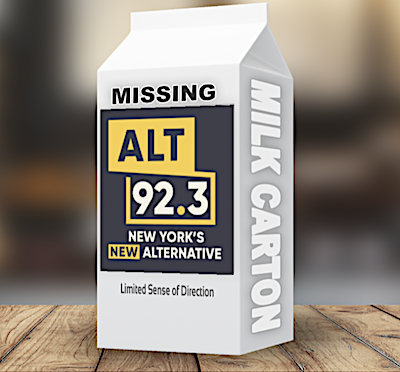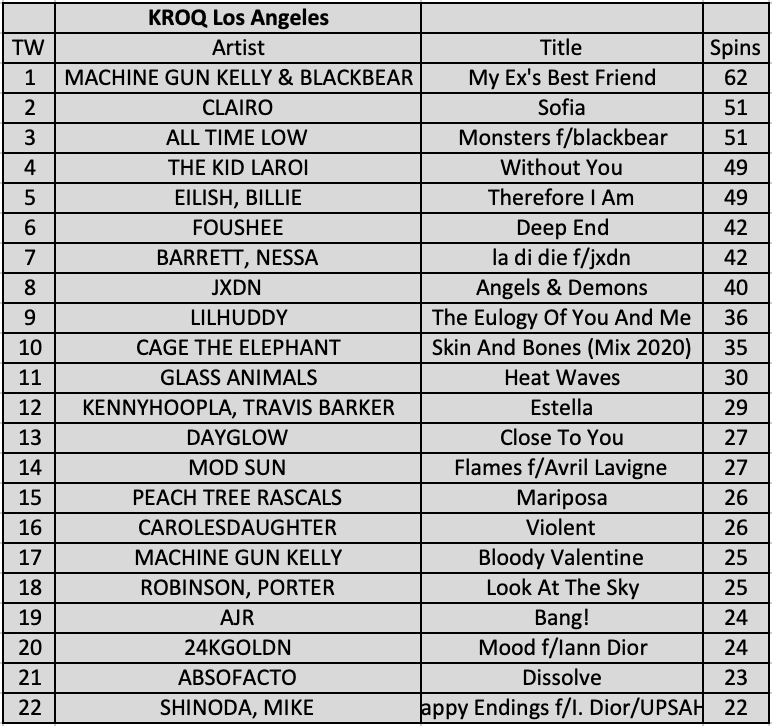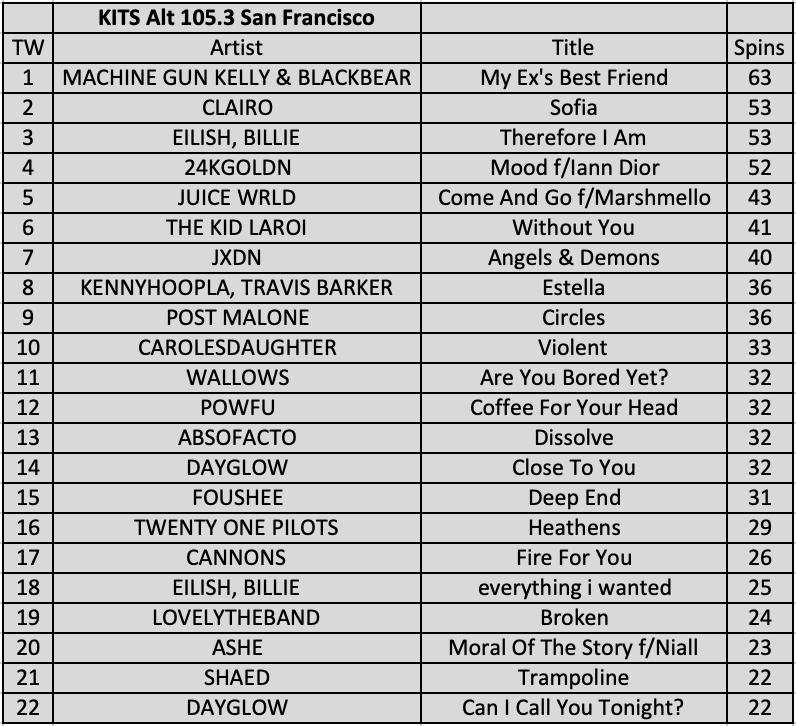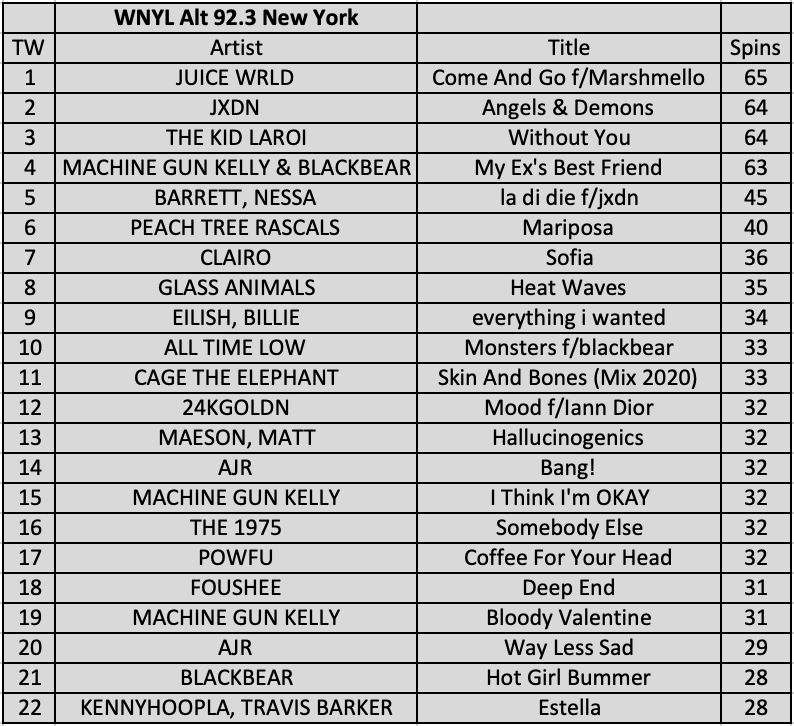Severe ratings problems in NYC, LA, and SF are the result of systemic problems with execution…
 By Paul Marszalek
By Paul Marszalek
TheTop22.com
Update 3/1/21: I’m adding this note to reflect the considerable feedback I’ve received since posting this piece. Generally speaking, that feedback has come from two constituencies; The overwhelming majority saying, “Thank you for saying this out loud,” and a second, very much smaller group taking some level of offense. This is not the intent. It is an attempt to ring some alarm bells at senior levels in an effort to course correct these stations.
To clarify, the idea here is not to debate artists, the value or lack thereof of TikTok, or the history of Alternative Rock Radio. The question is whether or not the ALT format, as currently executed by a major radio corporation, is actually viable. Apologies to any great radio and label folks who felt this piece was unhelpful. However, we need great radio — and these stations can be be just that.
The problems Entercom is having with its ALT format are mounting, with myriad execution issues resulting in breathtaking under-performance in major markets.
The January Nielsen ratings are in, and it’s more of the same.
In Los Angeles, legendary call letters KROQ have become increasingly meaningless as the station posts just a 1.7 share – suddenly looking up at niche players like KCRW (1.8) and even Classical KUSC (2.1). Those may be apples-to-oranges comparisons, but direct format competition confirms trouble as iHeart’s ALT 98.7 appears to pull away in January, posting a 2.7 share.
In San Francisco, the legendary Live 105, re-branded as ALT 105.3, is riding a 1.5 – 1.4 – 1.3 trend. Putting up a moribund 1.3 in San Francisco with an “alternative” format is actually not that easy to do.
New York’s ALT 92.3 cannot get itself over radio’s version of the Mendoza Line, posting another sub 2-share at 1.9. This, despite a cume of more than a million people and a programming strategy entirely focused on minimal commercial interruption.
The “two minute promise (no more than 2 minutes of commercials at a time)” pounded by ALT 92.3 should deliver what we used to call Time Spent Listening (TSL). But it isn’t, so something else is going very wrong.
In listening to Entercom’s ALT stations, there are dozens of execution errors that collectively account for their failure.
I’ll focus on just two of the biggies: 1) Botched music segmentation, and 2) a lack of brand authenticity.
The Top 22 songs played on KROQ, ALT 105.3, and Alt 92.3 in the last seven days (courtesy Mediabase).



In reviewing the playlists of Entercom’s ALT stations, it becomes quickly apparent that there is a heavy corporate hand in the decision-making. Further, some of that centralized decision-making appears to have been outsourced to TikTok.
The TikTok-ing of the ALT format causes a couple of issues relating to music segmentation — a lot of TikTok hits simply don’t fit together. A radio segue from Clairo to a classic from Red Hot Chili Peppers basically frustrates two sets of listeners, and this constant flushing of audience is the primary reason for the lack of TSL. It’s almost impossible to listen to Entercom ALT stations for more than two consecutive songs.
TikTok-ing has resulted in the importation of a steady stream of white-kid pop songs that don’t have a lot in common with the idea of Alternative. Billie Eilish is lightning in a bottle. Much of the rest, while often quite good, will ultimately result in little more than a flash in the pan. ALT, as executed, is manifesting itself as a never-ending string of often name-interchangeable one hit wonders with a dash of career artists sprinkled in.
A music segmentation study could help solve this very disjointed sound.
Compounding the TSL issue may be oppressive rotations. Perhaps designed to address short bursts of commuter and in-car listening, 65 spins a week can wear thin quickly in a stuck-at-home environment. New York’s ALT 92.3 played Machine Gun Kelly’s “My Bloody Valentine” roughly 65 times/week since June of 2020, now settling in at just 4-5 times per day in 2021. After 1800 spins, is it possible that fatigue has set in?
A white-kid pop song approach to a radio format might be a great idea, but you can’t pass it off as Alternative. The idea that songs that are omnipresent on a teen social media platform are also “Alternative” is incongruent.
Not to take anything away from Mod Sun/Avril Lavigne’s “Flames,” but three plays a day on World Famous KROQ? And 23 spins a week for 2017’s “Dissolve” from Absofacto? How about a dozen plays of Gotye’s 2011 hit “Somebody I Used to Know?” This, from the station that used to cause near-riots in support of bands like Depeche Mode?
The problems at San Francisco’s ALT 105.3 (formerly the great Live 105) can be summed up by its 36 spins last week of Post Malone’s “Circles.” Incredible pop song. Also currently #5 at Adult Contemporary.
Houston, we have a problem, and the problem is branding. Every time these stations say they’re Alternative they lie – and a big chunk of the audience knows it.
Great brands deliver on great brand promises. Telsa – cutting edge technology. McDonalds – consistent, cheap, ok burgers, great fries. Spotify – instantly gives me music I like.
A simple way to gauge the success of a brand is to simply ask yourself, “Why am I here? Why am I buying this?” You might answer with things like price, design, durability, convenience, new.
It works with radio too. “Why am I here? Why am I listening to this instead of something else?” When I ask myself that question of Entercom’s ALT stations, I kind of draw a blank. I’m honestly not sure what the value proposition is.
ALT 92.3 keeps interrupting the music to tell me that they don’t play many commercials. They then follow it with commercials. After the commercials, they tell me again. It’s weird.
Until Entercom gets some vision behind its ALT approach, expect these stations to struggle, if not disappear.
 -The Top 22 – Triple A, Indie, Alternative Rock
-The Top 22 – Triple A, Indie, Alternative Rock


When Entercom stripped the Buzz branding from KRBZ (Kansas City) and removed Lazlo (who was a core part of the brand) from music decisions, I debated with a handful of radio “professionals” who said the branding didn’t matter to the listeners as long as they liked the music. My counter was that the Buzz brand (and KROQ, Live 105, etc.) at their best had a specific stated set of values and principles that the audience responded to. “ALT” doesn’t. It’s a nebulous soup of everything – but stands for very little, and as a result, gives the audience nothing to be deeply passionate about. As a result, the stations become easily replaceable – because whichever cluster of music you like most, it’s not going to satisfy you.
To borrow from an alternative classic, these stations are the son and heir of nothing in particular. Whereas the KCRW’s and KEXP’s of of the world make it clear where they stand – and as a result, are seeing ratings growth and people actually care enough to support them financially. I’m not sure what commercial radio plans to do about it or their next move, but I sincerely hope they have one.
I MISS “my” DJ’s here in Portland, Oregon. They made it personable.
I’m interested to see how, say, Alt 98.7’s top songs compare with KROQ’s.
Lately, KROQ Los Angeles sounds like the playlist of an uncool 14 year-old white girl.
Hey Paul,
I’m of the opinion that corporate influence lessened alternative rock’s presence in the mainstream and lessened alternative radio’s popularity. Would you agree? It’s obvious that Entercom is trying to revitalize the format for a younger audience, and failing miserably at that. But corporate attempts to “poppify” the format have been present since at least the early-2010s. Examples: the rise of pop band AJR to the point where they’re a format mainstay, and in 2018 when Mike Posner was given airplay and artists such as Muse and Thirty Seconds to Mars cheapened their sound in an attempt to sound more like Imagine Dragons. Entercom is in a sad state but iHeartRadio and even Cumulus are nowhere near innocent.
As a bonus question, what do you personally think alternative radio should play? I believe rock should be embraced, not shied away from. Chevelle and Deftones both have great singles out right now that are available for radio play. Fontaines D.C., Rolling Blackouts Coastal Fever, The Dirty Nil, July Talk, Spanish Love Songs, Beach Bunny, PUP, The Regrettes, Bleached, Tennis, Real Estate, and Future Islands are all bands that sound different, but they all have alternative rock appeal. I think radio would benefit from playing artists like them. Would they all segue together in a radio segment? Maybe, maybe not. Either way, it’s an improvement.
Hi Richard,
Thanks for the comments. I think one of the points I failed to land in the post is that I’m not really trying to debate Pop versus other genres, my question is really more about whether the format that these stations are executing is actually a viable format at all. I don’t believe it is.
I don’t believe Alternative is dead, but I think we now have enough evidence that ALT is a dud.
Alternative likely has a much better chance of success with an older target incorporating artists such as those you suggest. Think 25-54, with a super cell target of 30-45, spilling up toward 50. NON-COMMs are pulling this off with their direct funding model from station members.
Thanks again!
Paul
chevelle?!!
puh-leeeeze!!!
now, you’re spot on with Fontaines DC
but missed IDLES.
Don’t knock Chevelle, “Self Destructor” is an epic banger and in general Chevelle hews closer to Deftones and Tool (who play alternative rock but with downtuning to create alternative metal) than say Godsmack or FFDP (who are more straight-forward rock).
The fact that Chevelle made the Billboard chart at #37 and is one spot ahead of “Hot Girl Bummer” of all songs says a lot about the current state of the format and how divided some station’s playlists are.
Corporate playlists are killing radio, period. Even the companies that once claimed to be “live and local” have thrown the towel in on local programmers and it shows.
The funny thing here is that Stryker & Kline is a good show. Funny, not hacky, and edgy for an Alt format. But as soon as they moved them in the K&B spot under those circumstances, I saw it as them setting up for fail. The company has talent but bad PR moves baking made over and over again.
I second. Felt kevin and bean had their best days 10 years behind them and Stryker and klein were hungry and growing a loyal fan base in the pm. But they did them no favors. As an audio file I like them better than heidi and frank, woody, etc, but they were sacrificial lambs and with the unfamiliar music to boot. SMH
Paul,
You are correct and Richard is spot on. Entercom is trying to change alternative to a younger crowd by adding TikTok songs and more pop music. If you look at almost any Entercom alternative Facebook page from DFW to Portland to Vegas you will see how unhappy the listeners are since the format change. Yes the ratings have dropped because if Covid but between syndicated shows and lack of real alternative music every Entercom station is tanking and will continue to do so unless change is made.
Appealing to younger people is important because otherwise you’ll wind up like Active Rock, which is on borrowed time due to the lack of young people tuning in, and unable to achieve any significant crossover hits to pop (absolutely essential for keeping a format’s vitality).
The issue is HOW Entercom is doing it. Format captain Mike Kaplan is throwing the baby out with the bathwater and going all-in on TikTok songs and pop music. If it weren’t for the pop-punk revival movement gaining steam, Kaplan wouldn’t be playing any modern alternative music (in a recognizable sense) on Entercom stations. It’s too much, too fast, and too reliant on something nebulous, we don’t know if any of the TikTok stars have any real staying power.
They also aren’t supplying a true music discovery outlet for Zoomers. Entercom alternatives are extremely reliant on recurrent tracks. WNYL, for example, plays “Come & Go” by Juice WRLD 64 times a week. While recurrent tracks are an essential part of any station’s playlist, 64 spins for an aging song is programming malpractice. Why “3 Nights” and “coffee for your head” are getting 30 spins a week is beyond me. They create a feeling of a playlist that’s staid even as it tries to be hip.
Also, you need the veteran staple artists and their new singles to keep things stable and to keep long-time listeners tuning in in case the new artists and songs don’t work out. Kaplan has opted to order the Entercom stations to NOT play these staple artists (Kings of Leon, Foo Fighters, Weezer, etc.). This does not only put an artificial ceiling for these staple artists on the chart but makes their absences from the playlist conspicuous, contrary to what Kaplan thinks many Zoomers do listen to these artists. They don’t have a stigma against veterans like Millennials do. So the Zoomers are going to notice this, too.
Entercom Alternatives also have an issue with mixing the songs – yesterday they put a Rage Against The Machine classic, “Guerrilla Radio” next to “Come & Go” by Juice WRLD and “Bang!” by AJR. There is such a clash in sounds here, it’s jarring.
Finally, the DJs are clearly being stretched thin. They’re exhausted by having to voice-track for so many different stations. Their break-ins sound canned and uninspired, and definitely don’t sell the illusion of being live. iHeart is guilty of this too mind you but their DJs are better at hiding it (and probably aren’t being overworked as badly). I get that Entercom is in dire financial straits but the DJing is embarrassingly bad, and that is a detriment to the experience.
So Entercom’s issues are 1. trying too hard to appeal to Zoomers, 2. at the same time being too tentative to alienate Millennials, which results in a playlist that makes no one happy, 3. jarring music transitions, 4. exhausted, demoralized, and uninspired DJing, 5. too much centralized control by one format captain who can overrule all stations nationwide, and 6. carelessly tossing out format staples that are needed for format and listener continuity.
It’s a daunting prospect to fix. I do not envy whoever has to try to fix this mess.